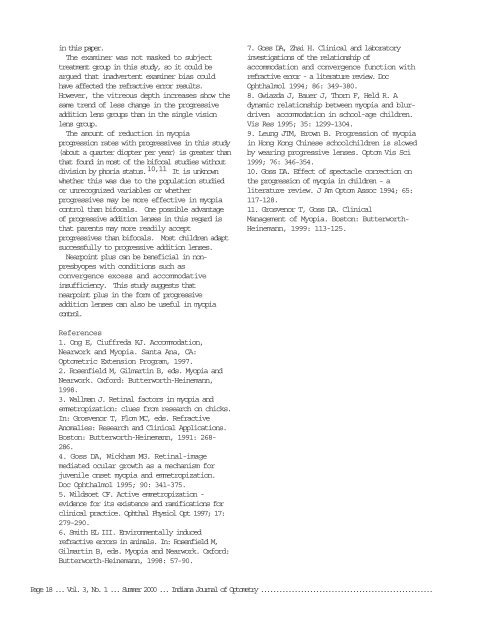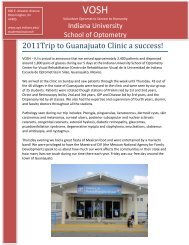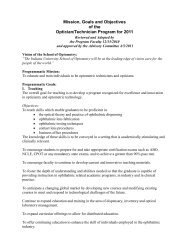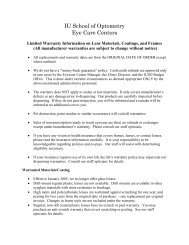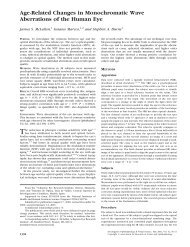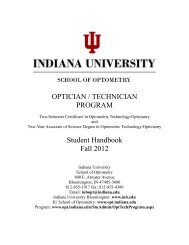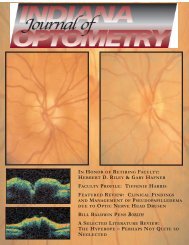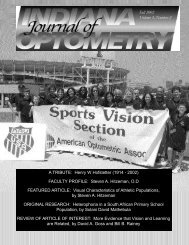Summer 2000 - Indiana University School of Optometry
Summer 2000 - Indiana University School of Optometry
Summer 2000 - Indiana University School of Optometry
Create successful ePaper yourself
Turn your PDF publications into a flip-book with our unique Google optimized e-Paper software.
in this paper.<br />
The examiner was not masked to subject<br />
treatment group in this study, so it could be<br />
argued that inadvertent examiner bias could<br />
have affected the refractive error results.<br />
However, the vitreous depth increases show the<br />
same trend <strong>of</strong> less change in the progressive<br />
addition lens groups than in the single vision<br />
lens group.<br />
The amount <strong>of</strong> reduction in myopia<br />
progression rates with progressives in this study<br />
(about a quarter diopter per year) is greater than<br />
that found in most <strong>of</strong> the bifocal studies without<br />
division by phoria status. 10,11 It is unknown<br />
whether this was due to the population studied<br />
or unrecognized variables or whether<br />
progressives may be more effective in myopia<br />
control than bifocals. One possible advantage<br />
<strong>of</strong> progressive addition lenses in this regard is<br />
that parents may more readily accept<br />
progressives than bifocals. Most children adapt<br />
successfully to progressive addition lenses.<br />
Nearpoint plus can be beneficial in nonpresbyopes<br />
with conditions such as<br />
convergence excess and accommodative<br />
insufficiency. This study suggests that<br />
nearpoint plus in the form <strong>of</strong> progressive<br />
addition lenses can also be useful in myopia<br />
control.<br />
7. Goss DA, Zhai H. Clinical and laboratory<br />
investigations <strong>of</strong> the relationship <strong>of</strong><br />
accommodation and convergence function with<br />
refractive error - a literature review. Doc<br />
Ophthalmol 1994; 86: 349-380.<br />
8. Gwiazda J, Bauer J, Thorn F, Held R. A<br />
dynamic relationship between myopia and blurdriven<br />
accommodation in school-age children.<br />
Vis Res 1995; 35: 1299-1304.<br />
9. Leung JTM, Brown B. Progression <strong>of</strong> myopia<br />
in Hong Kong Chinese schoolchildren is slowed<br />
by wearing progressive lenses. Optom Vis Sci<br />
1999; 76: 346-354.<br />
10. Goss DA. Effect <strong>of</strong> spectacle correction on<br />
the progression <strong>of</strong> myopia in children - a<br />
literature review. J Am Optom Assoc 1994; 65:<br />
117-128.<br />
11. Grosvenor T, Goss DA. Clinical<br />
Management <strong>of</strong> Myopia. Boston: Butterworth-<br />
Heinemann, 1999: 113-125.<br />
References<br />
1. Ong E, Ciuffreda KJ. Accommodation,<br />
Nearwork and Myopia. Santa Ana, CA:<br />
Optometric Extension Program, 1997.<br />
2. Rosenfield M, Gilmartin B, eds. Myopia and<br />
Nearwork. Oxford: Butterworth-Heinemann,<br />
1998.<br />
3. Wallman J. Retinal factors in myopia and<br />
emmetropization: clues from research on chicks.<br />
In: Grosvenor T, Flom MC, eds. Refractive<br />
Anomalies: Research and Clinical Applications.<br />
Boston: Butterworth-Heinemann, 1991: 268-<br />
286.<br />
4. Goss DA, Wickham MG. Retinal-image<br />
mediated ocular growth as a mechanism for<br />
juvenile onset myopia and emmetropization.<br />
Doc Ophthalmol 1995; 90: 341-375.<br />
5. Wildsoet CF. Active emmetropization -<br />
evidence for its existence and ramifications for<br />
clinical practice. Ophthal Physiol Opt 1997; 17:<br />
279-290.<br />
6. Smith EL III. Environmentally induced<br />
refractive errors in animals. In: Rosenfield M,<br />
Gilmartin B, eds. Myopia and Nearwork. Oxford:<br />
Butterworth-Heinemann, 1998: 57-90.<br />
Page 18 ... Vol. 3, No. 1 ... <strong>Summer</strong> <strong>2000</strong> ... <strong>Indiana</strong> Journal <strong>of</strong> <strong>Optometry</strong> ........................................................


